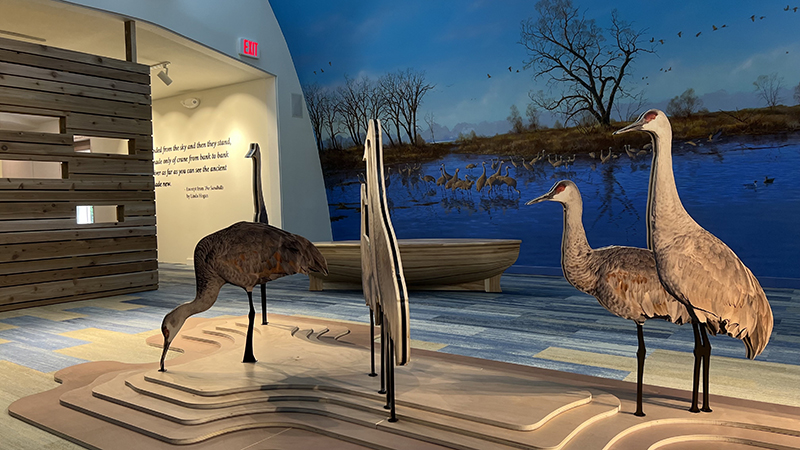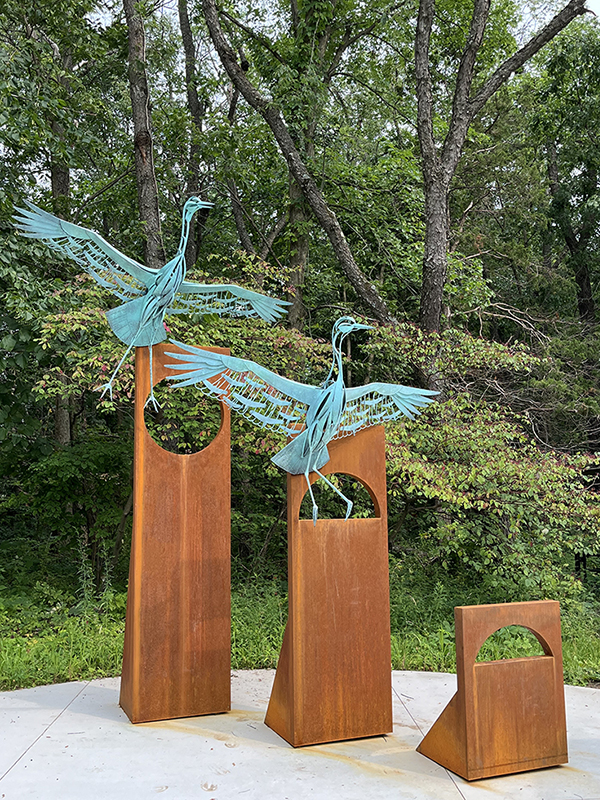
CONTACT: Ryan Michalesko, Communications & Advocacy Specialist, 608-356-9462 ext. 113
July 23, 2024 – Baraboo, Wis. – For just a few weeks each year, more than half a million Sandhill Cranes and a handful of endangered Whooping Cranes descend upon a short stretch of Nebraska’s Platte River in one of nature’s great migrations. Now, visitors to the Cranes of the World at the International Crane Foundation’s global headquarters can experience the sights and sounds of these birds on the Platte River up close through our newly renovated Migration Center.
“The migration of Sandhill Cranes each Spring at the Platte River in Nebraska is truly spectacular,” said Darcy Love, Managing Director-Cranes of the World. “This is an opportunity for people of all ages and abilities to take a step into that special—and critical—environment.”
The central Platte River is vital to Sandhill and Whooping Cranes as a key stopover site on their more than 5,000-mile migration northward. The river serves as a staging area where cranes rest and replenish their energy before continuing their journey to nesting grounds in Canada, Alaska, and Siberia.
For many visitors, the highlight of the new Migration Center is a dome mural depicting this gathering of cranes. The breathtaking mural was created by artist Victor Bakhtin in 1995 for the Foundations’ original welcome center. Bakhtin, who died in 2016, was a world-renowned wildlife artist born in Siberia in the Soviet Union. With the help of several people in Wisconsin, Bakhtin emigrated in 1992 and became an Artist in Residence at the International Crane Foundation.
“This space was the introduction to every tour that began at the International Crane Foundation for over three decades. We are very excited for guests to enjoy Victor’s legacy once again,” Love added. “Many visitors remember this space from class field trips and delight in sharing their memories of it with their own families.”
The revitalized mural is accompanied by sounds and sculptures of Sandhill Cranes, immersing guests in the migration of the world’s most abundant crane species (the Sandhill Crane) and the rarest (the Whooping Crane). As visitors step in, they can peer through slots on a viewing blind, as if watching the migration right from the banks of the Platte River. As they continue through the Center, they can look up to see the wrap-around mural depicting the migration on all sides.
The Migration Center, which opened earlier this summer, is already drawing attention from visitors, new and old.
“It really was extraordinary for this mural to be the first thing visitors saw when entering in years past,” said Jean Ashmore, longtime Cranes of the World volunteer. “It’s even more exciting that this space is back for its second life for new generations to experience.”

Nestled between the Wisconsin Dells, Baraboo Bluffs, and Wisconsin River, the 15-acre Cranes of the World exhibit area is the only place to see all 15 crane species from around the globe. In addition to the new Migration Center, visitors can see the world’s tallest flying bird (the Sarus Crane from Southeast Asia stands six feet tall) and the rarest crane (fewer than 900 North American Whooping Cranes are alive today).
The Cranes of the World at the International Crane Foundation is open daily from 9 a.m. until 5 p.m. (last entry is 4:30), May 1 through October 31 each year. Guided Public Tours are offered at 10 a.m., 1 p.m., and 3 p.m. on Saturdays and Sundays in May, September, and October and seven days a week in June, July, and August. “This is a unique spot for visitors,” Ashmore said. “It’s peaceful, educational, and accessible. I just know people will love it.” Plan your summer visit here.
